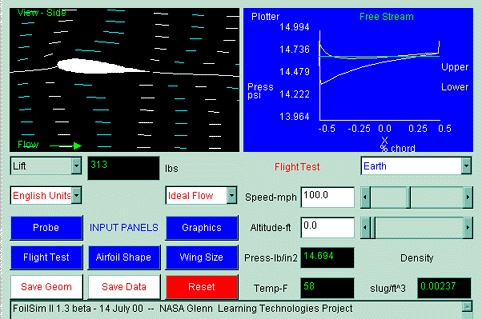|
|
Beginner's
Guide to Aerodynamics and FoilSim
Lift Equation Activity
Subject Area:
Algebra I, Physical Science, Physics
Grade level:
9-12
National Mathematics
Standards:
- Construct and draw
inferences from charts, tables, and graphs that summarize data from
the real world.
- Represent and analyze
relationships using tables, verbal rules, equations, and graphs.
- Use tables and
graphs as tools to interpret expressions, equations, and inequalities.
- Operate on expressions
and matrices, and solve equations and inequalities.
National Technology
Standards:
- Research Tools
- Use content-specific tools, software and simulations (e.g., environmental
probes, graphing calculators, exploratory environments, Web tools) to
support learning and research.
- Problem-Solving
and Decision-Making Tools - Routinely and efficiently use on-line
information resources to meet needs for collaboration, research, publications,
communications, and productivity.
Objective:
- After reading an
explanation from a NASA Web-based textbook, you will demonstrate an
understanding of the text by using it, along with FoilSim, to complete
an activity to graph and interpret the lift equation.
-
Beginner's Guide to
Aerodynamics is a "textbook" of information prepared at NASA Glenn Research
Center to help you better understand how airplanes work. Click
Beginner's
Guide Index to access the list of slides. Open the slide called
Lift Equation (with
text) and read the explanation on how the amount of lift depends on the
size of the object. Then using the information shown at Lift
Equation Activity, complete the problem designed to demonstrate your
ability to graph, interpret, and solve the lift equation.
FoilSim is an interactive
simulation software package that examines the airflow around various shapes
of airfoils. As you change parameters such as airspeed, altitude, angle
of attack, thickness and curvature of the airfoil, and size of the wing
area, the software calculates the lift. The package was created at the NASA
Glenn Research Center.
FoilSim II is a Java applet program that executes inside the browser of your computer.
It is available on the World Wide Web at
http://www.grc.nasa.gov/WWW/K-12/airplane/foil2.html.
You can also
download the program to run off-line.
Shown below is a screen
shot from the program's controls and displays. You may change the values
of the variables by using the slider or the input box on the left of the
slider.
To use the slider:
- Click the mouse
pointer on the arrows at the ends of the slider.
- Click the mouse
pointer anywhere between the slider and the arrow.
- Drag the slider
with the mouse.
To use the input
box:
Simply select the
value in the input box, key in the new value, and press Enter or Tab when
finished. The button on the slider will move corresponding to the value
typed in the box.

Click here to begin
the Lift Equation Activity.
Assessment:
- You,
or you and your partner(s), will be evaluated on the accuracy or feasibility
of your answers.
Evaluation:
- You will demonstrate
the ability to use information found on the World Wide Web to graph
and apply the lift equation.
Submitted by:
Melissa Hughes, Cardinal High School, Middlefield, Ohio
|
